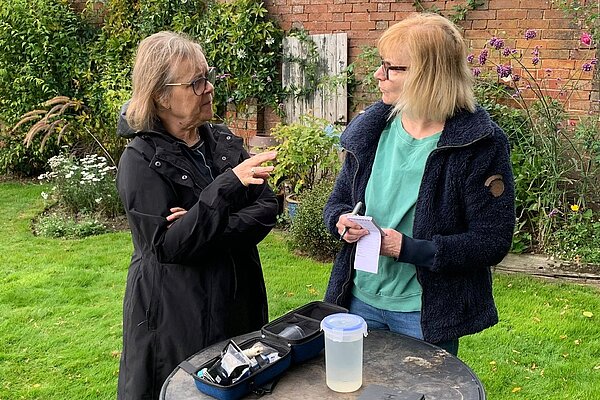Cranleigh River Tests Reveal Shocking Pollution Levels
Last month, Cllr Liz Townsend joined local Water Ranger Cathy Gould to test the water quality in Cranleigh Waters, just downstream of the village’s sewage treatment works in Elmbridge Road. The results were deeply troubling — showing levels of pollution far above what would be expected in a healthy river.
The tests recorded phosphate levels of 0.88 mg per litre (mg/L) — that’s 880 parts per billion (ppb). Under the UK’s Water Framework Directive (WFD) standards, a healthy river in “good” ecological condition should have no more than 0.05–0.1 mg/L of phosphate. At 0.88 mg/L, Cranleigh Waters’ phosphate levels are roughly nine times higher than the upper limit for “good” status, which is indeed a serious pollution reading.
High phosphate levels feed algal blooms that choke aquatic life, reduce oxygen levels, and destroy the natural balance of the river ecosystem.
Even more worrying, the nitrate level was over 10 mg/L, far above what is considered healthy for a river. Good ecological status is typically achieved with nitrate levels below 1 mg/L, with unpolluted rivers often below 0.5 mg/L. Over 10 mg/L, as measured in Cranleigh Waters, indicates severe pollution consistent with untreated or partially treated sewage entering the system, contributing to excessive plant and algae growth, depleting oxygen, and leaving little room for fish, insects, and other wildlife to survive.
In addition, Cathy measured a conductivity level of 629 µS/cm (microsiemens per centimetre) — the highest she has recorded in Cranleigh Waters. Conductivity measures how well the water conducts electricity, which increases with higher concentrations of dissolved salts and pollutants such as nitrates, phosphates, and other ions. In unpolluted rivers, conductivity typically ranges from 150 to 500 µS/cm. Readings above that can indicate contamination from sewage and agricultural runoff.
Cathy Gould, one of Cranleigh’s volunteer Water Rangers, said:
“Our rivers should be thriving with wildlife, but what we’re finding is water that’s overloaded with nutrients and pollution. These levels are simply not sustainable for a healthy river.”
The tests were taken at a point just beyond the Cranleigh Sewage Treatment Works, which has been the focus of increasing concern in recent months. Residents have reported that the storm overflow system, designed to operate only during periods of heavy rainfall, has not been functioning properly for many months. This raises the risk that untreated or partially treated sewage is entering the river far more often than it should.
The malfunctioning overflow has been reported to the Environment Agency, which has confirmed that it is investigating the problem. Cllr Liz Townsend has also raised the matter with Ofwat, the national water regulator, urging a full investigation and immediate remedial action by Thames Water.
Cllr Townsend commented:
“This is unacceptable. Our communities expect Thames Water to manage its infrastructure responsibly and protect the environment, not pollute it. The evidence from the Cranleigh Waters Rangers shows our river is in real trouble, and urgent action is needed.”
The Cranleigh Waters Rangers are part of a Surrey-wide volunteer monitoring network, supported by environmental groups and local councils. Their regular testing provides vital, independent data on water quality — helping to hold water companies and regulators to account and shining a light on problems that might otherwise go unnoticed.
Waverley Liberal Democrats are calling for greater transparency and accountability from water companies, stronger enforcement by the Environment Agency, and investment in modernising sewage infrastructure to protect our local waterways.
